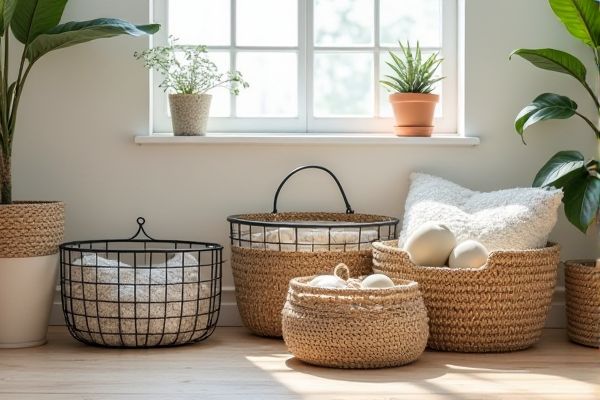
Wire baskets offer superior durability and ventilation compared to plastic baskets, making them ideal for storing items that require airflow and easy visibility. Discover which option best suits your storage needs by reading the rest of the article.
Table of Comparison
| Feature | Wire Baskets | Plastic Baskets |
|---|---|---|
| Material | Metal wires (steel, iron) | Durable plastic (polypropylene, polyethylene) |
| Durability | High strength, rust-resistant if coated | Resistant to moisture, less prone to damage |
| Weight | Heavier due to metal composition | Lightweight and easy to carry |
| Ventilation | Excellent airflow, prevents moisture buildup | Varies; often limited ventilation |
| Maintenance | Requires occasional rust prevention | Easy to clean and maintain |
| Cost | Generally higher price | More affordable |
| Usage | Ideal for storage, organization, durable needs | Great for lightweight storage and portability |
| Environmental Impact | Metal is recyclable and long-lasting | Plastic may be less eco-friendly unless recycled |
Introduction to Wire Baskets and Plastic Baskets
Wire baskets offer durability, breathability, and a sleek industrial aesthetic, making them ideal for organizing heavy or bulky items in warehouses and homes. Plastic baskets provide lightweight, moisture-resistant storage solutions with a variety of color options, suitable for kitchens, bathrooms, and outdoor use. Both types of baskets serve distinct organizational needs based on material strength, ventilation, and environmental exposure.
Material Composition and Durability
Wire baskets, typically made from steel or stainless steel, offer superior durability and resistance to heavy loads compared to plastic baskets, which are usually constructed from polypropylene or polyethylene. Metal composition provides enhanced strength, heat resistance, and longevity, making wire baskets ideal for industrial or heavy-duty storage. Plastic baskets are lightweight and resistant to corrosion but tend to degrade under UV exposure and may crack under significant stress or temperature fluctuations.
Aesthetic Appeal and Design Options
Wire baskets offer a sleek, industrial aesthetic with their open, metal framework that complements modern and minimalist interior designs. Plastic baskets provide a wider range of colors, shapes, and patterns, allowing for greater customization and vibrant decor options. Wire baskets tend to emphasize durability and transparency, while plastic baskets prioritize versatility and visual variety in design.
Weight and Portability
Wire baskets typically offer lighter weight compared to plastic baskets, enhancing portability for carrying and storage. The metal construction of wire baskets often includes open designs, reducing material use and overall mass. Plastic baskets, although sometimes heavier, can provide more rigidity and impact resistance, balancing portability with durability.
Storage Capacity and Versatility
Wire baskets offer superior storage capacity and versatility due to their open design, allowing you to easily see and access items while maximizing vertical space. Plastic baskets often have solid sides, limiting airflow and visibility but providing better protection from moisture and dust. Your choice depends on whether you prioritize easy access and adaptability or durability and containment for varied storage needs.
Maintenance and Cleaning Requirements
Wire baskets require minimal maintenance due to their sturdy metal construction, allowing easy cleaning with a damp cloth or mild detergent to prevent rust and dirt buildup. Plastic baskets are lightweight and water-resistant, making them simple to wash with soap and water, but may stain or crack over time with heavy use. Your choice depends on maintenance preferences, with wire baskets offering durability and plastic baskets providing convenience in cleaning.
Cost Comparison
Wire baskets typically have a higher upfront cost due to durable metal materials and manufacturing processes, whereas plastic baskets are generally cheaper and more affordable for bulk purchases. Over time, wire baskets may offer better value as they resist wear, corrosion, and deformation, reducing replacement frequency compared to plastic baskets that can crack or fade. Choosing between these options depends on your budget and the intended usage environment, balancing initial investment against long-term durability.
Environmental Impact and Sustainability
Wire baskets are generally more eco-friendly than plastic baskets due to their durability and recyclability, significantly reducing landfill waste and resource consumption. Plastic baskets often contribute to environmental pollution since they degrade slowly and require petroleum-based materials, increasing carbon footprint. Choosing wire baskets supports sustainability by promoting reuse and reducing plastic pollution, making it a better option for your environmentally conscious needs.
Suitable Applications and Use Cases
Wire baskets excel in retail and industrial settings for storing heavy or bulk items due to their strength and ventilation, making them ideal for tools, hardware, and produce. Plastic baskets are preferred in household and healthcare environments because they resist moisture, offer easy cleaning, and provide lightweight portability for laundry, food storage, and medical supplies. Choosing between wire and plastic baskets depends on specific needs such as durability, hygiene, and the nature of stored materials.
Conclusion: Choosing the Right Basket
Wire baskets provide durability, ventilation, and a sleek industrial look ideal for heavy-duty storage and organizing items that benefit from airflow. Plastic baskets offer lightweight convenience, moisture resistance, and affordability, making them suitable for everyday household use and moisture-prone environments. Selecting the right basket depends on specific needs such as load capacity, environmental factors, and aesthetic preferences to optimize functionality and longevity.
 homyna.com
homyna.com